December 2024
The global veterinary lasers market size was accounted for USD 314.67 million in 2024, grew to USD 342.17 million in 2025 and is projected to surpass around USD 727.36 million by 2034, representing a CAGR of 8.74% between 2025 and 2034. The North America veterinary lasers market size is calculated at USD 123.18 million in 2024 and is expected to grow at a CAGR of 8.89% during the forecast year.
The global veterinary lasers market size is estimated to surpass around USD 727.36 million by 2034 increasing from USD 314.67 million in 2024, growing at a CAGR of 8.74%. The growing demand to treat several conditions in pets, such as injuries, diseases, and arthritis, is growing the requirement for the veterinary lasers market, which focuses on reducing pet’s inflammation and pain and improving wound healing.
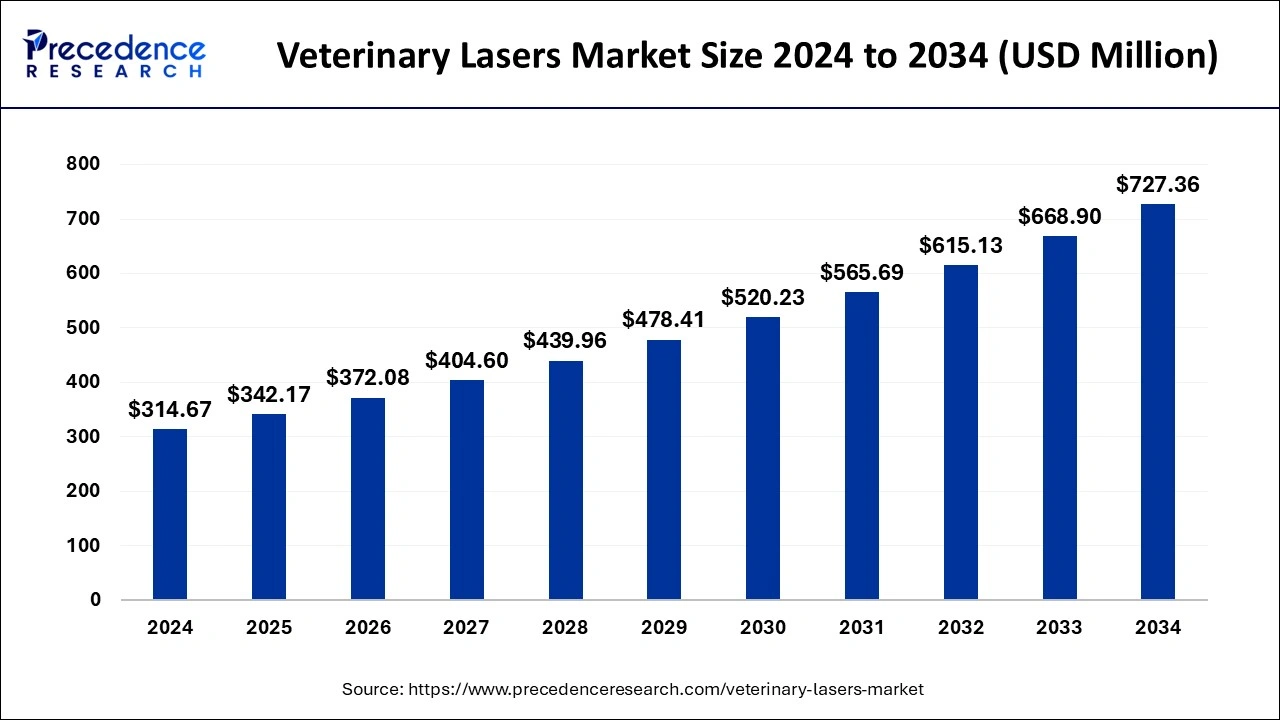
The integration of artificial intelligence in the veterinary lasers market is an innovative future that holds the potential to enhance the quality of care for animal companions. The Internet of Things (IoT) in veterinary practices has developed significant advancement, especially in precision veterinary laser therapy. IoT is equipped with interconnected devices, sensors, and software systems that provide real-time data collection, analysis, and remote monitoring. The application of IoT in veterinary laser therapy is diverse and evolving, and it includes chronic pain management, such as osteoarthritis. IoT-equipped laser therapy allows for precise and tailored treatment plans. In wound healing, IoT monitors and records the progress of healing for later analysis.
The U.S. veterinary lasers market size was exhibited at USD 79.30 million in 2024 and is projected to be worth around USD 187.17 million by 2034, growing at a CAGR of 8.97% from 2025 to 2034.
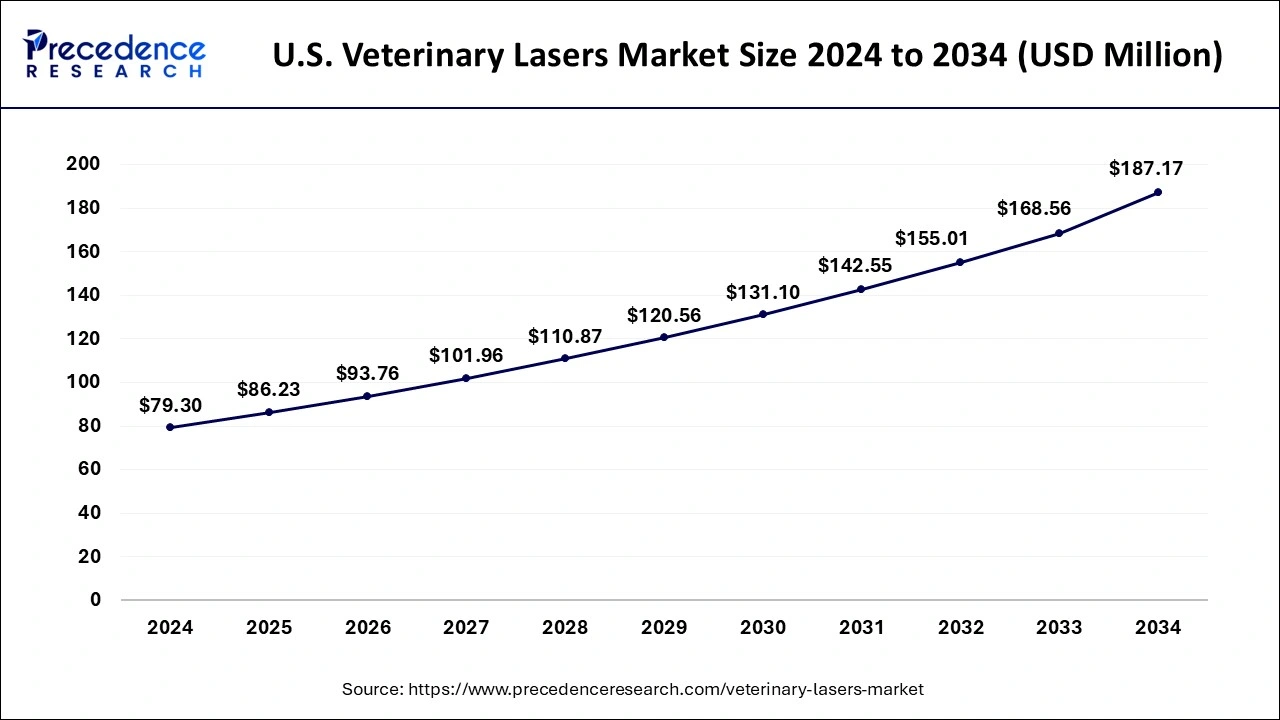
North America dominated the global veterinary lasers market with the largest market share in 2024. The dominance of the region is experienced due to the expansion of new veterinary healthcare facilities around the nation which is proven to be significantly improving animal care and service accessibility. More clinics and hospitals are available in North America. Moreover, there are healthcare facilities for zoo animals which is creating more opportunities for specialized treatment, using modern medical technologies.
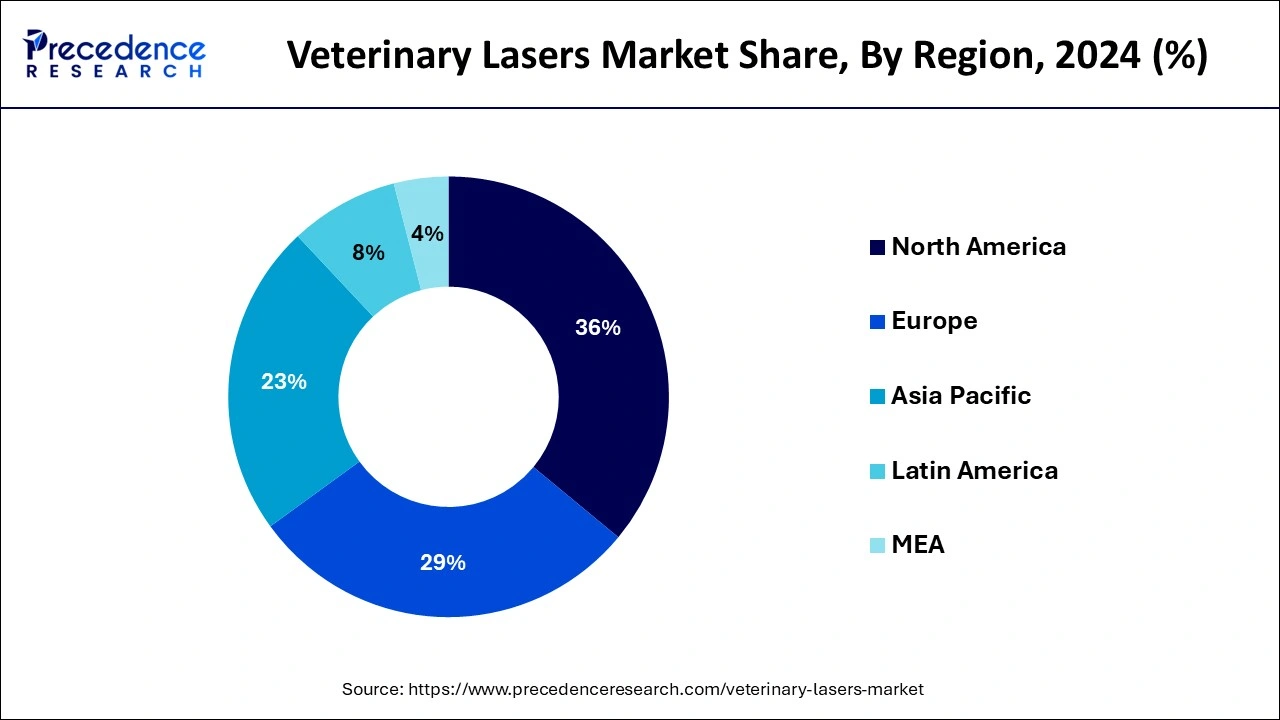
Asia Pacific will witness significant growth in the veterinary lasers market during the forecast period. The growth of this region is credited to the large adoption of pets. Pet humanization is creating diverse opportunities in food, care, service, and healthcare fields. In Asia Pacific, pet adoption has proliferated in the last decade, with 60% of citizens having a pet at home and 32% of the population reporting their dogs and cats as their best friends. This is commonly noticed in China. Over 55% of pet parents consider feline and canine companions as their children.
Veterinary laser therapy is a pioneering treatment for pain management, inflammation (swelling), and wound healing. The laser and wound interaction is known as photobiomodulation. The veterinary lasers market techniques use light of a single wavelength, ranging from visible red to infrared. Laser therapy is an easy treatment with no side effects for pets. Laser therapy is commonly used for arthritis pain, surgical incision healing, wound healing, soft tissue injuries, ligament sprain or strain, and lick granulomas.
| Report Coverage | Details |
| Market Size by 2024 | USD 314.67 Million |
| Market Size in 2025 | USD 342.17 Million |
| Market Size in 2034 | USD 727.36 Million |
| Market Growth Rate from 2025 to 2034 | CAGR of 8.74% |
| Dominating Region | North America |
| Fastest Growing Region | Asia Pacific |
| Base Year | 2024 |
| Forecast Period | 2025 to 2034 |
| Segments Covered | Product, Animal, Application, Class, End-use, and Regions |
| Regions Covered | North America, Europe, Asia-Pacific, Latin America, and Middle East & Africa |
Ownership and pet insurance
The prevalence of pet owners and the development of pet insurance are the primary reasons for the growth of the veterinary laser market. Pet ownership is a rising global trend, especially among the millennial generation. Families in the United States, Brazil, European states, and China account for over a million dogs and cats as pets in their homes. Every pet owner chooses a safe and convenient way of living for their pet. Combined with the growing insurance of pets, is driving the market. Any basic pet insurance policy plan covers all major surgeries and treatments, along with the expenses of vet fees, diagnostics tests, medicines, drugs, and many more.
Cost of laser therapy
The cost of the veterinary lasers market treatment depends upon the condition or illness. There are various factors that could be a price concern when it comes to laser therapy. Factors such as whether it is a long-term treatment or a short-term treatment, geographic location, and other variables affect the price range. The average estimated cost range of laser treatment in pets ranges from USD 40 to USD 100 per session.
Treatment associated complications
If the veterinary lasers market procedure is carried out properly with the right settings and treatment length, then the therapy is safe and works very well. However, there is a chance that the laser will cause burns if it is not used correctly. Laser therapy is strictly prohibited to use over tumors, the eyes, testicles, and growth plates in bones and a pregnant uterus.
Acupuncture laser
The incorporation of acupuncture in the veterinary lasers market is anticipated to be witnessed in the coming future. This is an ancient Chinese technique that uses needles to stimulate acupoints and provide various health benefits. The combination of therapeutic laser and acupoint has the potential to transform the veterinary medicine field. Cold laser therapy can be used to stimulate acupuncture points, and studies show that this practice is effective for analgesia, such as acute pain, arthritis, perioperative pain, and vomiting.
The therapeutic laser segment contributed the highest share of the veterinary lasers market in 2024. When a pup is given a therapeutic laser treatment, the pet is receiving a low-level or cold laser therapy, this technique lowers the pain and encourages healing. The healing is credited to the release of endorphins, decrease in the release of inflammatory chemicals, dilation of lymphatic vessels, and increased blood flow to the wounded area. Pet sedatives are not mandatory in this procedure as long as they rest comfortably.
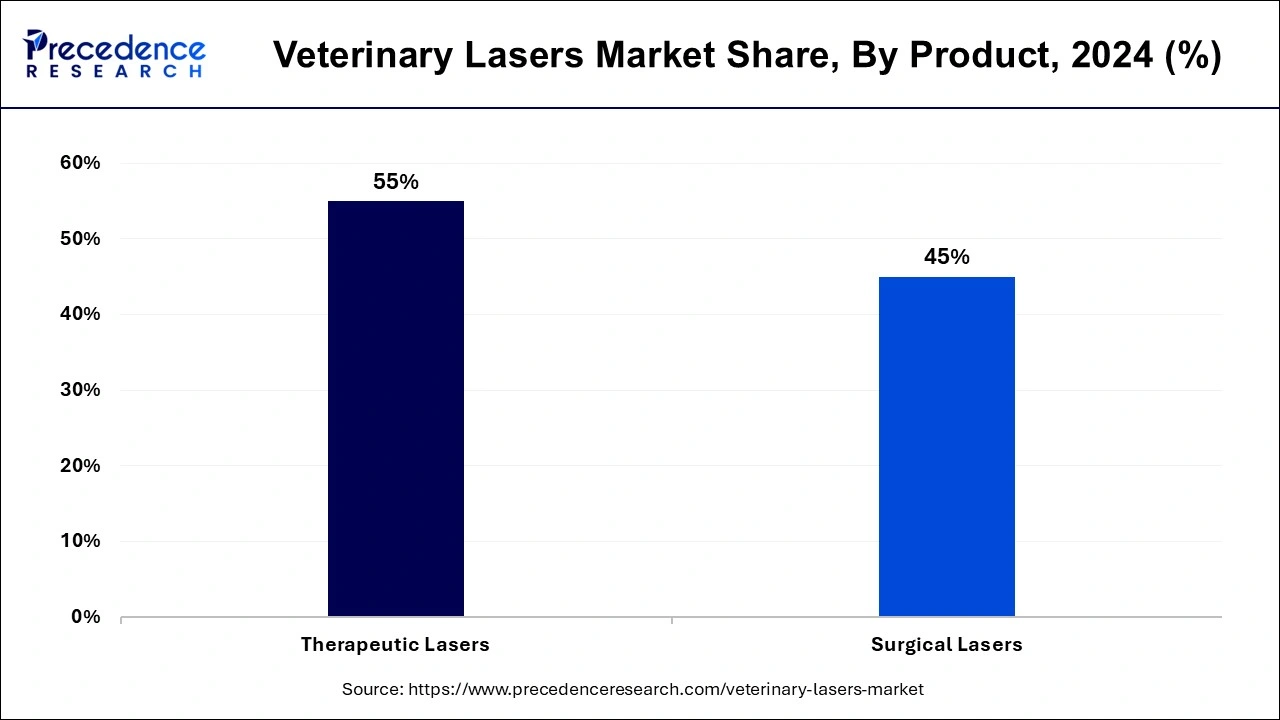
The surgical laser segment is anticipated to grow at the fastest CAGR in the veterinary lasers market during the forecast period. The expansion of this segment is noticed as this procedure has less pain, less bleeding, and less swelling compared to conventional surgery. Additionally, pets are not at risk of infection; the laser is a precision surgery that removes unhealthy tissues while minimizing side effects around the tissue. Laser surgical procedure is widely used on dogs, cats, birds, reptiles, exotics, horses, and many more. Commonly, laser surgeries are oral/dental surgery, spays and neuters, dermatology problems, and tissue removal.
The dogs segment led the global veterinary lasers market in 2024. The dominance of this segment is observed due to the larger ownership of dogs than cats. All dog owners are concerned about their well-being and opt for a better, safer, and faster recovery therapy option, which is laser therapy, which has no risk of negative adverse effects and can reduce pain and inflammation and provide healing.
The cats segment is expected to grow significantly during the forecast period. The growth of this segment is expected to rise as cats may have to receive more laser therapy treatment than dogs. Cats suffering from severe pain cannot consume pain medication as frequently as dogs can. Therefore, laser therapy treatment is an ideal pain relief therapy for cats.
The class 3 segment accounted for the highest share of the veterinary lasers market in 2024. The class 3 laser therapy is commonly used for therapeutic lasers purpose. It is generally safe for skin and eyes under specific conditions. Class 3 laser penetrates the skin to deliver photons that stimulate healing in injured tissue. Class 3 laser therapy is used in a variety of conditions, including pain, both acute and chronic, muscle spasms, edema reduction, wound healing, and tinnitus.
The class 4 segment is projected to grow at the fastest rate in the veterinary lasers market during the forecast period. Class 4 laser therapy causes thermal injury to the tissues, and it is used for surgical laser purposes such as cuts and cauterizing tissues during surgical procedures. It is not safe for the eyes and skin. The user must have protective eye goggles on. The demand for class 4 laser type is due to its production of high energy laser which allows the treatment time to be much shorter.
The pain and inflammation management segment accounted for the highest share of the veterinary lasers market in 2024. When a pet is suffering from a chronic disease, such as liver disease, that cannot be treated with conventional pain medication, Laser therapy is used to manage pain. Laser therapy promotes the release of hormones and chemicals that help in the reduction of pain. Additionally, it stimulates the reduction of inflammation. Laser therapy is recommended by veterinarians for post-surgical pain management to help manage pain and inflammation after surgery. Along with that, it is also used in musculoskeletal injuries, neurological diseases, wounds, and pain.
The regeneration/tissue repair segment is anticipated to grow with the highest CAGR from 2025 to 2034. The low-level lasers encourage tissue repair, reducing pain and inflammation. In laser therapy, body cells absorb the light energy, mend the damaged or injured tissue, and heal the wound. This stimulation of cell repair and regeneration also leads to fading of scar tissue and burns. The laser creates a microscopic tunnel in the scar tissue, creating a way for the growth of normal skin. With this, animals are regaining the ability to move and reduce pain.
The veterinary hospitals and clinics segment contributed the highest veterinary lasers market share in 2024. The growing popularity of laser therapy has become a standard practice that is widely available at specialty clinics or rehabilitation facilities. It can also be available in some private practices.
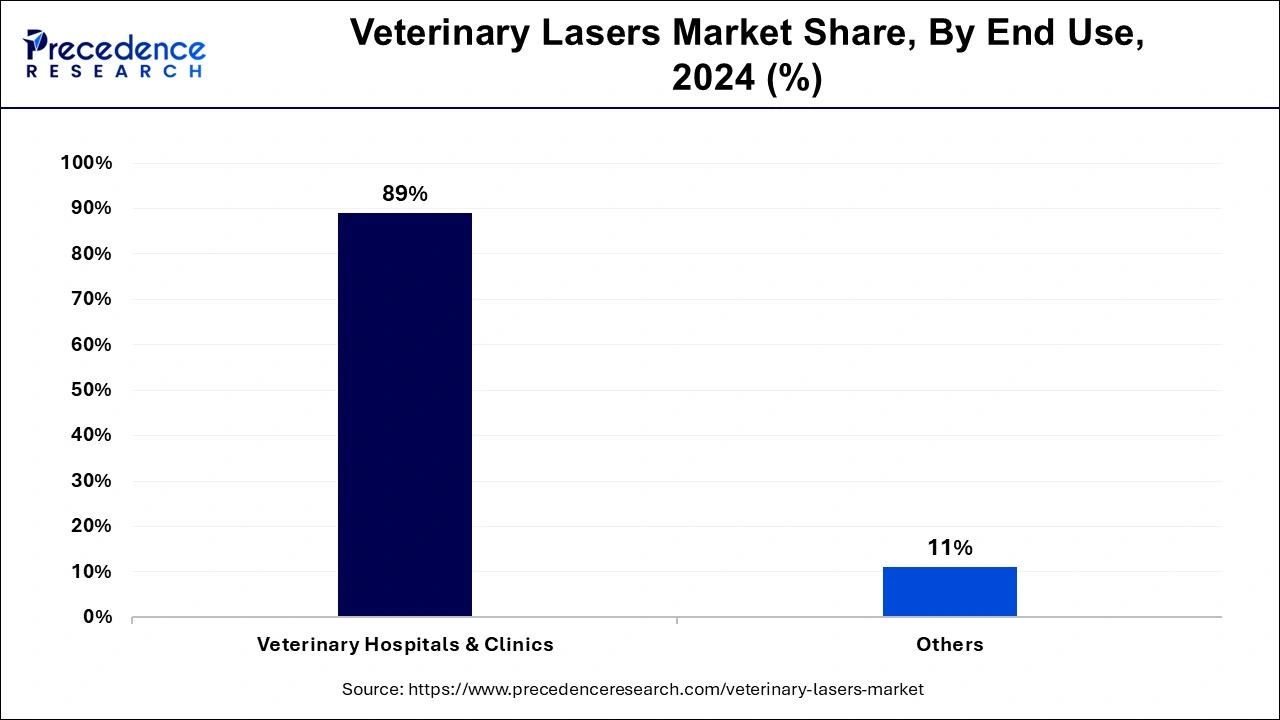
Laser therapy is carried out in hospitals and clinics under expert supervision and nurse care. A veterinarian working in hospitals and clinics suggests diet, exercise, vaccines, and medication for the pet according to the breed, condition, and health to enhance nutrition and formulation for treatment.
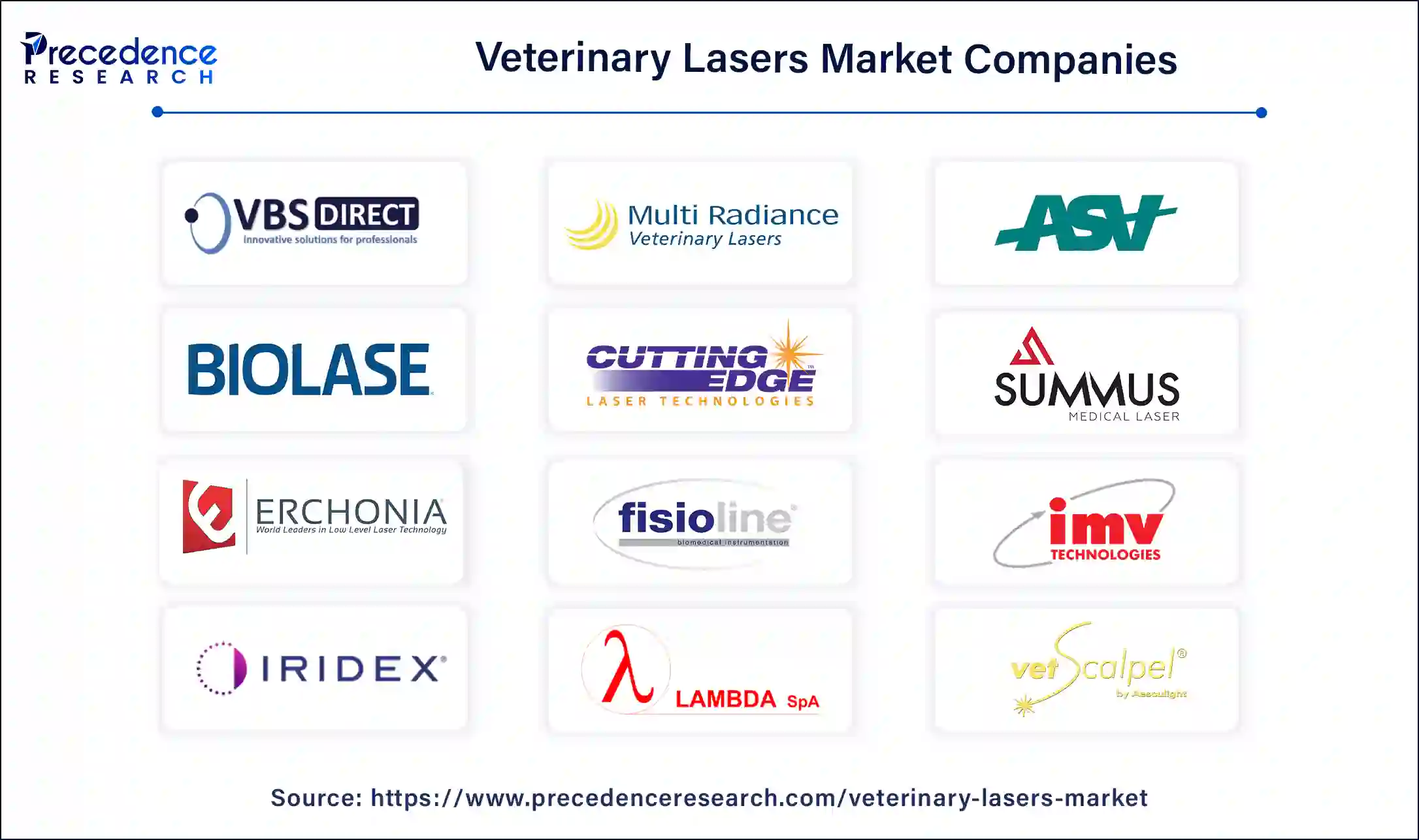
Recent Developments
By Product
By Animal
By Application
By Class
By End-use
By Geography
For inquiries regarding discounts, bulk purchases, or customization requests, please contact us at sales@precedenceresearch.com
No cookie-cutter, only authentic analysis – take the 1st step to become a Precedence Research client
December 2024
December 2024
August 2024
November 2024